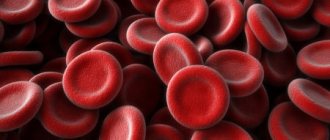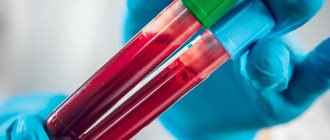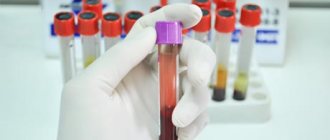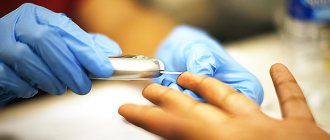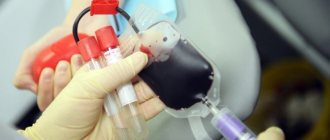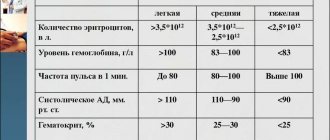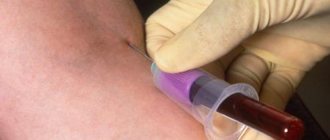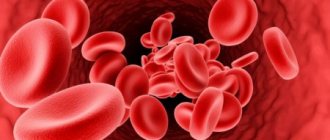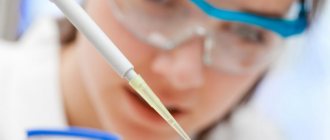Preparation rules
- To donate blood from a finger prick, you need to come to the laboratory in the morning (usually collection occurs from 7.30 to 10 o’clock).
- The test must be taken on an empty stomach, that is, you cannot eat in the morning, you can only drink plain water. The last meal should take place the night before - no later than 8-12 hours before the procedure.
- You can eat a day earlier, but it is recommended that a day or two before the analysis, in order to avoid getting distorted results, you should avoid fatty foods and alcoholic beverages.
- The day before, you should avoid physical and emotional stress.
- In the morning before the procedure, you should refrain from smoking.
What are finger-prick lancets?
Many patients are interested in what lancets for collecting blood are. Taking blood from a finger is a procedure that an adult or child must undergo at least once in their life.
But while adults tolerate the tests normally, children are afraid of this procedure, especially of pricking their finger with a needle.
But technology does not stand still, so for several years now an automatic scarifier has been used instead of a conventional device.
Blood sampling with this device is painless, since a special device called a lancet is used for analysis. This device can be used to analyze even infants.
Automatic lancet
What is a lancet for collecting blood from children?
This is a device with a plastic body into which blood is taken from the finger of a child or adult.
Such devices are used for taking capillary blood, general analysis and measuring sugar. The design includes a needle that children cannot see, so they can sit quietly and not be afraid to donate blood from their finger.
The needle is small in size, triangular in shape, and made of special medical steel.
The needles are called automatic lancets, are disposable, and extend out of the housing when a button is pressed. Only then does the finger pricking device come into contact with the skin and the analysis is taken.
The needle is hidden behind a cap that screws on. This makes the device convenient to use for both older children and newborns.
The doctor is also protected because the device prevents him from accidentally hurting himself. The needle appears only when the button is pressed.
An automatic lancet is considered a very reliable and economical device that helps to take blood from a finger.
There are a huge number of companies that produce such products, which are in great demand in medicine today. Among the general characteristics, the following are distinguished:
- The device is universal, and the needle is disposable. A clean, sterile needle is used for each patient.
- Lancets have different color marks, which allows you to control the number of samples taken, their volume, features and skin type.
- It is used not only for drawing blood, but also for making a puncture puncture in the ear and heel.
- The needle is a 25G type, with a puncture depth of 1.5 to 1.8 mm.
- Devices can be sold with different numbers of needles - from 50 to 200 pieces.
- Sometimes a thicker needle is used, and the puncture has a greater depth, which is associated with the type of skin and its condition.
A lancet for drawing blood from a finger to determine blood sugar levels is the same needle for a glucometer, which is selected based on the patient’s individual indicators.
Suitable for children are lancets for glucometers, which are considered ultra-thin, have a thickness of 0.25 to 0.8 mm, and their length is 1.2 - 1.8 mm.
The needle is sharpened by a laser, which makes the puncture almost invisible. As a result, the wound heals quickly and little blood appears on the finger.
The most popular among doctors are lancets, which are universal and automatic. Although there are also mechanical devices.
Before using a glucometer needle, it must be sterilized. Needles should be stored for no longer than 3 months, so their consumption must be carefully planned so as not to buy extra ones.
Using the lancet
The positive qualities of this device include the following factors:
- Devices designed for collecting blood do not cause pain or bruises, and there is no wound left after the puncture.
- The depth of the puncture does not depend on how hard the nurse pricks the needle.
- The device can be reused.
- The design is sterile, it is packaged in a special container, which is opened before use. But before this, the packaging must be treated with special gamma rays.
- The duration of blood sampling is only a few seconds. Universal lancets help to obtain the most reliable analysis results. Manual puncture with a conventional scarifier affects the blood and reduces the reliability of the examination results, while a lancet helps to obtain more accurate analysis data. The blood immediately enters the device, so it does not interact with air.
- The device can be used at home. It can be used by diabetics to measure glucose without visiting the hospital.
- The puncture site heals quickly, which allows injections to be given to babies up to one year old.
Lancets should be used according to the following scheme:
- First you need to treat with gamma radiation.
- Then remove the sealed packaging by turning it 90º.
- Unscrew and remove from the device (scarifier) the special cap that protects the needle.
- Press the device tightly against your finger.
- Press the button, pressing the body against the skin.
- Collect the required amount of blood.
Lancets used for children are disposable, so the devices must be disposed of after the procedure.
The device cannot be reused because after the analysis is taken, the needle is retracted back into the body and blocked.
This helps protect patients from injury and infection. The device with the collected material must be submitted to the laboratory for examination, which will help to conduct additional tests and detect infections, if the baby has any.
To measure blood glucose levels at home, you need to use another device. For these purposes, a lancet is used, which is universal and inserted into the glucometer.
This helps to save a lot on needles. Before discarding the device, it must be sterilized.
What types of lancets are there?
The doctor decides what type of device to use. If this needs to be done at home, then you should consult a therapist.
This is due to the fact that there are a huge number of lancets that differ from each other. Typically, the devices that are available in pharmacies are represented by the following models:
- The Medlance Plus automatic lancet comes in two types: blue - universal, with a needle length of 1.8 mm, and lilac, which is used for children. The latter have slightly thinner needles and are designed to penetrate to a depth of 1.5 mm.
- Qlance also comes in two colors - purple and blue. In the first case, the needle has a diameter of up to 0.45 mm, and the volume of blood that can be taken is 100 μl. The blue device is intended for adults as the needle diameter is about 0.89 mm.
- The orange scarifiers are Vitrex Sterilance Lite II. They stab quite deeply - up to 1.8 mm.
- Prolance devices come in four colors - green, blue, indigo and yellow. The needle diameter ranges between 1 and 1.8 mm. Typically used for testing on adults.
- MimiСollect models are available in purple and are also suitable for adults. The puncture depth can reach 1.2 mm.
- The Acti-lance model is available in two variations: disposable and universal. Disposable ones are purple in color and pierce the skin to a depth of 1.5 mm. And the universal lancet is blue, has a thicker needle and makes a puncture up to 1.8 mm.
- Automatic MR scarifiers are manufactured by the Chinese company Zhen Wu. There are a large number of models that are suitable for collecting capillary blood and obtaining general analysis results.
Source: https://oberon.blizko.ru/articles/118368
General analysis
It can be shortened or expanded. The first option includes indicators such as the level of hemoglobin and all blood cells (erythrocytes, platelets, leukocytes), as well as ESR (erythrocyte sedimentation rate).
Capillary blood collection from a child
In a detailed analysis, other indicators are added, including:
- hematocrit;
- width of red cell distribution;
- average erythrocyte volume;
- average content of hemoglobin in the red cell;
- leukocyte formula and others.
Tools
Many people are concerned about their own safety during the test, so they may have questions about what is used to pierce and take blood. Today, almost all medical institutions have switched to using disposable finger pricking instruments. This tool is called a scarifier. It must be removed from the unopened package in front of the patient. It should be said that such a puncture is quite painful, so children really do not like the procedure.
We advise you to read:Normal blood counts
Today, donating blood can be painless. A new device is being used more and more often when blood is taken. This is an automatic lancet in a plastic case. The needle quickly penetrates the skin, so pain is not felt. The new lancets have many advantages:
- the sterile needle or blade is located inside the body, which ensures the safety of patients and medical personnel;
- the reliability of the trigger mechanism eliminates accidental release of the needle or blade;
- reuse is eliminated thanks to the automatic return of the needle or blade;
- the shape of the needle ensures a reduced pain effect;
- the puncture is targeted, its depth is controlled;
- convenient body shape.
What are lancets
This device is called a needle for a glucometer (a portable device that shows the concentration of dextrose in the blood). This small device has an ultra-thin needle that provides a painless injection.
After using the lancet, the wound heals quickly, leaving no scars.
The device is convenient for everyday use. Harmful microorganisms, particles of dust and dirt do not get on the needle, since it is protected by a cap.
The use of scarifying needles is gradually fading into the background. After all, with their help it is not always possible to accurately calculate the applied force so as not to make too large a cut.
With a lancet you can avoid such incidents. You don't need to make any effort to make a puncture.
The needles are made of good materials and treated with gamma radiation, which ensures the sterility of the product.
The procedure using a needle lasts 2–3 seconds. The adult and the child will not even have time to understand what happened.
Fence algorithm
To work, the laboratory assistant must prepare:
- sterile scarifier;
- cotton wool;
- alcohol;
- tincture of iodine;
- ether.
Disposable scarifier - a tool for pricking a finger
The algorithm and technique for taking are as follows:
- The patient sits opposite the laboratory assistant. The hand (usually the left) lies on the table.
- The puncture site is disinfected with alcohol and degreased with ether.
- Using a disposable scarifier, a puncture is quickly made in the pad of the ring finger, immersing the tool to the full depth of the cutting part (approximately 2-3 mm).
- The first drop of blood is removed using dry cotton wool.
- For the study, use the second and subsequent drops of blood, which are collected using a glass adapter, then placed in test tubes and signed.
- After the blood has been taken, the injection site is treated with alcohol or iodine and clamped with a cotton swab until the blood stops completely.
The algorithm for collecting capillary blood from a child is exactly the same as from an adult.
How do you prick your finger for a blood test? – Mother and child
06.04.2020
Blood is taken from a finger in the following cases:
- for general analysis to determine cellular composition;
- to determine the glucose level (in this case, blood is also taken from a vein, but the sugar level will be slightly different, which is normal);
- express analysis to determine the level of total cholesterol (venous blood is required for a more detailed study).
Externally, blood from a vein and from a finger are slightly different. Venous is darker blood, capillary is light blood. Patients often wonder why they take a venous one, if taking it from a finger is easier and more convenient. It is believed that the best laboratories in the world work with venous tissue, and its study using new methods gives more accurate results.
Purpose
Blood is taken from a finger in order to:
- determine the composition of blood cells during a general examination;
- express diagnostics of blood sugar levels (in this case, a special device is used - a glucometer);
- express test to detect the level of total cholesterol (subsequently, venous blood donation is required to detail the results).
Preparation rules
- To obtain a more accurate result, a general blood test is taken from a finger prick in the morning (before 10 o’clock).
- Blood is donated on an empty stomach; you can have your last meal 12 hours before blood collection. On the day of the study, you are allowed to drink only clean water.
- For several days before the examination, it is recommended to exclude very fatty foods and alcohol from the diet.
- Also, a few days before the finger prick blood test, you should temporarily avoid heavy physical activity and try to worry less.
- Immediately before blood collection, smoking is not allowed.
- The equipment necessary for the procedure is prepared (sterile material, 70% ethyl alcohol solution or alcohol-containing antiseptics, disposable instruments, labeled slides and test tubes).
- Psychological preparation of the patient is carried out, during which the essence and methodology of the subsequent examination is explained to him and consent to conduct it is obtained.
- The patient is seated opposite the healthcare worker performing the blood draw and asked to place his hand on the table.
- The fingertip from which blood is taken is treated with an antiseptic and dried with a dry sterile cotton ball.
- Using a disposable instrument (scarifier, needle or lancet), a puncture is made to a depth of 2–3 mm.
- The first drop of blood is removed with a dry sterile cotton pad.
- To carry out the analysis, use the next ten drops of blood, which the laboratory assistant collects by gravity or draws into a special adapter. You should not squeeze your finger during the procedure, as this will lead to mixing of blood with tissue fluids, and the results of the blood test may be unreliable. The blood is placed in a special labeled tube with a reagent.
- After the procedure, a sterile cotton ball moistened with an antiseptic is applied to the injection site and held for 5 to 7 minutes until the bleeding stops completely.
Rules for collecting capillary blood
They consist in choosing the puncture site (it is done on the lateral areas of the heel) and in choosing the instrument with which device to take blood from infants. When working with this group of patients, automatic sterile lancets are used to reduce the sensation of pain in the child during skin puncture and blood sampling from a finger.
- To donate blood from a finger prick, you need to come to the laboratory in the morning (usually collection occurs from 7.30 to 10 o’clock).
- The test must be taken on an empty stomach, that is, you cannot eat in the morning, you can only drink plain water. The last meal should take place the night before - no later than 8-12 hours before the procedure.
- You can eat a day earlier, but it is recommended that a day or two before the analysis, in order to avoid getting distorted results, you should avoid fatty foods and alcoholic beverages.
- The day before, you should avoid physical and emotional stress.
- In the morning before the procedure, you should refrain from smoking.
General analysis
It can be shortened or expanded. The first option includes indicators such as the level of hemoglobin and all blood cells (erythrocytes, platelets, leukocytes), as well as ESR (erythrocyte sedimentation rate).
Capillary blood collection from a child
In a detailed analysis, other indicators are added, including:
- hematocrit;
- width of red cell distribution;
- average erythrocyte volume;
- average content of hemoglobin in the red cell;
- leukocyte formula and others.
Carrying out
There are two options for performing a general blood test:
- In the case of the first, laboratory assistants do an abbreviated analysis, which displays only the level of hemoglobin, blood cells and determines the erythrocyte sedimentation rate, that is, ESR.
- The second option involves conducting a detailed blood test, which also covers indicators such as hematocrit, average hemoglobin content in an erythrocyte, quantitative and qualitative composition of leukocytes, average erythrocyte volume and others.
When scheduling a clinical examination, the patient may have a question regarding what is used to prick the finger when blood is taken from it.
Due to the increased risk of infection with blood-borne diseases, primarily hepatitis and AIDS, in modern laboratories over the past decades, only disposable instruments have been used to collect biological material, which are removed from the packaging, which is opened in front of the patient.
To directly pierce a finger, devices such as scarifiers, sterile needles, and lancets for piercing a finger are used. If you use the first two, the puncture is more painful.
Today, laboratory technicians are increasingly inclined to use modern automatic instruments in which the lancet is placed inside a plastic case.
Disposable scarifier
Fence algorithm
To work, the laboratory assistant must prepare:
- sterile scarifier;
- cotton wool;
- alcohol;
- tincture of iodine;
- ether.
Disposable scarifier - a tool for pricking a finger
The algorithm and technique for taking are as follows:
- The patient sits opposite the laboratory assistant. The hand (usually the left) lies on the table.
- The puncture site is disinfected with alcohol and degreased with ether.
- Using a disposable scarifier, a puncture is quickly made in the pad of the ring finger, immersing the tool to the full depth of the cutting part (approximately 2-3 mm).
- The first drop of blood is removed using dry cotton wool.
- For the study, use the second and subsequent drops of blood, which are collected using a glass adapter, then placed in test tubes and signed.
- After the blood has been taken, the injection site is treated with alcohol or iodine and clamped with a cotton swab until the blood stops completely.
The algorithm for collecting capillary blood from a child is exactly the same as from an adult.
Why is the ring finger of the left hand
A completely logical question may arise as to why, for clinical research, capillary blood is taken primarily from the ring finger of the left hand, since blood is the same everywhere in the body.
Indeed, laboratory technicians use blood from the ring, middle or index fingers for this analysis. This is due to the anatomical characteristics of the human body. At the time of puncture there is always a risk of possible infection. In this case, the inner shells of fingers such as the thumb and little finger are directly connected to the inner shells of the hand.
If infected, the infection from these fingers will quickly spread to them, and then in a short time will spread to the entire hand. The membranes of those fingers that laboratory assistants select are isolated and, in case of infection, the infection will remain only in them for some time, which makes it possible to quickly suppress it.
Automated scarifier
Also, since the ring finger moves less than others, the wound after a puncture heals faster on it, which also serves to prevent infection.
Perhaps someone is interested in which finger the blood is taken from and why. The sampling occurs from the ring finger, although it is allowed from the middle or index finger.
A puncture, like any violation of the integrity of the skin, can lead to infection.
The ring, index and middle fingers have an isolated inner membrane, so if penetration occurs, the infection will first be localized, which means there is time to eliminate it.
What does the analysis show?
Taking blood from a finger is taken for preventive purposes, for diagnosis and treatment monitoring. This is a basic examination, and the main, most necessary characteristics for doctors that blood shows are the following:
- hemoglobin level;
- red blood cell level;
- ESR;
- leukocyte level;
- relative content of lymphocytes, monocytes, neutrophils, basophils, eosinophils.
Blood collection using an automatic lancet
Using clinical analysis, doctors can diagnose the following pathological conditions:
- leukemia;
- anemia;
- bleeding disorders;
- the presence of an infectious or inflammatory process in the body.
Decoding
The attending physician deciphers the general blood test. Of course, with the easy access to general tables of normal indicators that exist today, you can try to interpret the data yourself.
However, this should not be done, since the specialist who prescribed this examination evaluates not just the level of content of this or that parameter, but includes them in the overall clinical picture and compares them with other symptoms that the patient has:
- Hemoglobin, Hb - in women the normal value varies in the range of 120 - 140 g/l, in men - 130 - 160 g/l. An increase in hemoglobin levels may indicate dehydration of the body, various intestinal infectious diseases, and heart defects. A decrease indicates the development of anemia.
- Blood color index, CP - normal level is 0.85 - 1.15%. A decrease in the level of the color indicator of the blood indicates the development of anemia; an increase may accompany a violation of the synthesis of folic acid and oncological processes.
- Red blood cells - in women the norm is in the range of 3.7 - 4.7 g/l, in men - 4 - 5 g/l. An increase in the content of red blood cells can be observed both with minor disorders (diarrhea, burns, use of diuretics), and with the development of cancer and kidney pathologies. A low level indicates the development of anemia, blood loss, and the formation of edema.
- Erythrocyte sedimentation rate, ESR is a normal indicator in women - up to 20 mm/hour, in men - up to 15 mm/hour. Increased rates are observed in inflammatory and autoimmune pathological processes, cancer, disorders of the endocrine system, kidneys and liver. A decrease in indicators is characteristic of circulatory failure.
- Leukocytes - regardless of gender, the norm is 4 - 9 * 109 / liter. An increase in the level of leukocytes in the blood is observed during infectious processes; a decrease accompanies the development of cancer and hepatitis.
- Platelets are responsible for blood clotting, normally 180 - 320 * 109 / liter. High platelet counts are observed in rheumatoid arthritis, various forms of tuberculosis, and oncology. A decrease in platelet levels accompanies autoimmune diseases and anemia.
Source: https://lgp-himki.ru/razvitie/chem-prokalyvayut-palets-pri-analize-krovi.html
Why from the ring finger?
Perhaps someone is interested in which finger the blood is taken from and why. The sampling occurs from the ring finger, although it is allowed from the middle or index finger. A puncture, like any violation of the integrity of the skin, can lead to infection. The ring, index and middle fingers have an isolated inner membrane, so if penetration occurs, the infection will first be localized, which means there is time to eliminate it. The thumb and little finger are directly connected to the lining of the hand, and when infected, the infection spreads to the entire hand. The choice of the ring finger is explained by the fact that it bears the least physical load.
What is used to prick a finger during analysis?
A blood test is the most common diagnostic procedure. It is carried out at absolutely any age, as part of a comprehensive examination. An analysis in which blood is taken from a finger is called a general test.
In order for the result to be most reliable, the main principles of preparation and implementation of the procedure should be observed.
Why is blood taken from a finger?
What does a general blood test show? As a result, the study determines the number of certain types of blood cells. This is necessary for diagnosing various diseases.
The main functions of general analysis include:
- Hemoglobin level measurement,
- Platelet count,
- Determination of blood clotting abnormalities,
- Determination of the number of monocytes and lymphocytes,
- Measurement of the number of neutrophils, basophils and eosinophils,
The results obtained help determine the development of diseases such as:
- Anemia,
- Bone marrow diseases,
- Infectious or inflammatory diseases,
- Development of an allergic reaction,
- Diabetes,
- Cardiovascular diseases,
How to prepare properly?
The analysis will show a reliable result only if you prepare for it correctly. Is blood donated on an empty stomach or not? Treatment rooms in government institutions are open strictly in the morning. You cannot have breakfast before taking blood. In private clinics you can donate blood at any time.
The main principles of preparing for blood collection are as follows:
- The day before, he recommends avoiding foods rich in fats.
- You should not drink alcohol 1-2 days before donating blood.
- Immediately before visiting the treatment room, you should refrain from smoking,
- It is recommended to avoid stressful situations and physical activity the day before,
Types of blood sampling instruments
It is advisable to first find out how blood is taken for research. The degree of pain depends on the device for drawing blood. This function is performed by a scarifier for drawing blood. It is a thin steel plate with a pointed end. During the procedure, a puncture is made on the skin of the finger, through which blood flows out.
For children, a special device is provided that allows blood sampling to be done painlessly. It is called a lancet . The piercer is a special needle placed in a certain way, providing uniform pressure on the skin. Using the lancet is quite simple. The device works by contacting the skin or pressing a special button.
Taking blood from infants also does not cause any difficulties . For this purpose, you can use the Komarik kit for painless delivery. The set comes with 4 disposable needles. The mechanism of the device allows you to pierce with a needle without pain so that the child does not understand anything.
The advantages of a lancet over a scarifier are as follows:
- Speed of use,
- The possibility of hematomas at the puncture site is excluded,
- No pain
- Can be used at home,
- The appearance of the device does not cause emotional stress, which helps to obtain reliable results,
Procedure implementation process
How to take blood from a finger at home
To obtain the most reliable results, the puncture technique must be followed. Blood donation is carried out in a specially equipped sterile room. It is important to pay attention to the instrument used to prick when drawing blood. It should be disinfected.
The following items are required:
- Alcohol or other antiseptic,
- Piercing needles or scarifier,
- Glass for taking a smear,
- Iodine tincture,
- Ether,
The procedure algorithm is as follows:
- The upper phalanx of the ring finger of the left hand is treated with an antiseptic,
- The tool is directed strictly from the side, at an angle,
- The next step is to pierce the finger. When a drop of blood appears on the surface of the skin, it is removed with a sterile swab,
- A second drop of blood is used for the test.
- The blood collection method involves making smears. For this purpose, sterile glasses are used,
Which finger is best to take blood from?
Why is it common to take blood from the ring finger? The choice is due to the fact that this finger bears less physical stress. Injury to the damaged area of skin is unlikely. You can also take blood from your middle or index finger. This is practiced if plasma donation is carried out on a regular basis.
Any damage to the skin can lead to the spread of infection. The anatomical location of the index, middle and ring fingers eliminates the possibility of infection spreading to the hand due to the presence of an internal septum. Infection from the little finger or thumb spreads faster.
What is the difference between venous blood sampling and capillary blood sampling?
Rules for collecting capillary blood
Why do venous blood sampling if capillary blood donation is much easier? Venous blood analysis is more detailed. Even externally, there are significant differences between capillary and venous blood. The first is quite light, and the blood from the vein is dark. In laboratory conditions, it is much easier to work with a venous blood sample.
What is detailed analysis?
A comprehensive blood test is called a biochemical blood test. Blood taken from a vein is examined. It is prescribed when clinical analysis does not provide enough necessary information.
The advantages of this type of analysis are as follows:
- Accurate diagnosis of the disease,
- The ability to determine the level of vitamins in the body,
- The ability to identify the disease at an early stage, in the absence of characteristic symptoms,
Despite the fact that the general analysis shows less information, it also has its advantages.
These include the following:
- High speed of the procedure,
- Only pierce the skin surface. The depth of the wound does not exceed 3 mm,
- The fence rules are much easier to follow. This increases the reliability of the result,
- Capillary biomaterial is tested much faster than venous blood,
- In private clinics, the price for a general analysis is lower than the cost of a biochemical one,
Where to submit?
Doubts regarding your health sooner or later make you wonder how and where to take a general blood test. The answer to this question depends on the patient's requirements and capabilities.
There are three possible options:
- State clinic,
- Private clinic,
- Medical personnel visiting your home,
In the first case, the diagnostic procedure is carried out within the framework of health insurance. The analysis is absolutely free . The disadvantages of donating blood at a government institution include long queues and the procedure being carried out at a strictly fixed time. It takes more time to examine a blood sample, which cannot be said about private clinics.
You can take the test at a paid institution at any convenient time. The main condition is not to eat for more than 3 hours. It costs more to have a medical professional visit your home. The advantages of the service include the absence of the need to leave the walls of the house, which is especially important if the patient is seriously ill.
Analysis results
You can find out how much analysis is done immediately before donating blood. Typically, the duration of the study is from 5 to 7 days . In private clinics, the result is ready within 3-5 days after the collection procedure.
If you get bad results, you should remember the following:
- The possibility of error cannot be ruled out
- The reliability of the result depends on how correctly the medical worker takes the blood,
- Violation of the rules for preparing for analysis leads to an incorrect result,
- Before the procedure, do not rub your fingers. The resulting result will include increased white blood cell counts,
The results are interpreted by the attending physician. Self-medication is strictly prohibited.
General blood test norms
As a result of the analysis, data on the following parameters are presented:
- Hemoglobin,
- red blood cells,
- Reticulocytes,
- platelets,
- ESR,
- Leukocytes,
- Monocytes,
- Lymphocytes,
- granulocytes,
- color index,
A person who has passed a general analysis has a question about what result should be feared.
The following situations indicate the presence of serious diseases:
- Drop in hemoglobin level
- Increase in ESR,
- Increase in the number of leukocytes,
- Reduction of red blood cells,
Source: https://sosudamhelp.ru/chem-prokalyvayut-palecz-pri-analize.html
What does the analysis show?
Taking blood from a finger is taken for preventive purposes, for diagnosis and treatment monitoring. This is a basic examination, and the main, most necessary characteristics for doctors that blood shows are the following:
- hemoglobin level;
- red blood cell level;
- ESR;
- leukocyte level;
- relative content of lymphocytes, monocytes, neutrophils, basophils, eosinophils.
Blood collection using an automatic lancet
Using clinical analysis, doctors can diagnose the following pathological conditions:
- leukemia;
- anemia;
- bleeding disorders;
- the presence of an infectious or inflammatory process in the body.
How is blood drawn?
Let's analyze a general finger blood test as an event for the patient:
- The specialist selects a finger to take a sample. As a rule, it is nameless. Why? He participates less than others in the patient’s physical activities.
- The puncture site and adjacent areas of the skin are treated with a special antiseptic (disinfecting) solution.
- The skin is pierced with an applicator or blade.
- The first drop of blood is usually removed with a cotton swab. The subsequent ones in the required volume are collected with a special tube.
- Blood samples are placed by a specialist on a glass slide in a test tube.
- The puncture site is treated with an antiseptic, alcohol solution, and a tampon is applied to it.
As a rule, the procedure does not take more than 2 minutes. Modern applicators help to perform it as painlessly as possible for the patient.
Interpretation of results
Deciphering should be carried out only by the attending physician. You should not try to do this yourself based on tables that indicate the norm for each indicator. The doctor evaluates the main parameters not only individually, but also in aggregate.
- Hemoglobin level. The norm for women is 120-140 g/liter, for men – 130-160 g/liter. If the content is higher than normal, dehydration, intestinal infections, and congenital heart disease are possible. A low level indicates anemia.
- CPU (color index). The norm is from 0.85 to 1.15%. Low values indicate anemia; elevated values are observed with folic acid deficiency and stomach cancer.
- Red blood cells. The norm for men is 4-5 g/l, for women – 3.7-4.7 g/l. An increase in level indicates renal pathologies, tumors, Cushing's syndrome. A slight excess of the norm can be observed with diarrhea, taking diuretics, and burns. Low levels indicate anemia, overhydration, and blood loss.
- ESR. The red cell sedimentation rate is an indicator of the level of plasma proteins. Normally, in women – up to 20 mm/hour, in men – up to 15 mm/hour. A high level is typical for inflammatory processes, infections, autoimmune diseases, intoxication, endocrine, renal and hepatic pathologies, and oncology. The reasons for the decrease are circulatory failure, hyperbilirubinemia, erythremia.
- Leukocytes. The norm of white cells is 4-9X10⁹/liter. The reasons for the decrease are cancer with secondary tumors in the brain, diffuse connective tissue diseases, typhoid fever, viral hepatitis, leukemia. Increased levels are observed in bacterial and fungal infections, acute inflammation, purulent infections, pneumonia, otitis media, pancreatitis, bronchitis, meningitis, and so on.
- Platelets. The normal content of blood platelets responsible for blood clotting is 180-320X10⁹/liter. High platelet counts indicate the development of rheumatoid arthritis, polycythemia, tuberculosis, and myeloid leukemia. A reduced content accompanies thrombocytopenic purpura, aplastic and hemolytic anemia, hemolytic disease, and lupus erythematosus.
Characteristics and advantages of scarifiers (lancets)
- Painless puncture technique due to carefully adjusted sharpening geometry and inert silicone coating on the steel.
- No wounds or bruises are left after the procedure due to membranes that prevent the reverse flow of blood.
- Optimal puncture depth by eliminating the human factor.
- The minimum duration of sampling is a few seconds.
- Suitable for newborns.
- They are used not only in medical institutions, but also at home - for example, when using glucometers.
- Safety – technically impossible to reuse, injury to personnel is also excluded.
